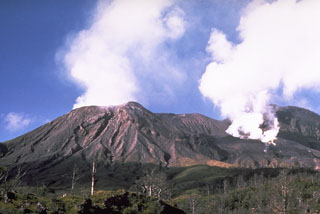Report on Langila (Papua New Guinea) — March 1981
Scientific Event Alert Network Bulletin, vol. 6, no. 3 (March 1981)
Managing Editor: Lindsay McClelland.
Langila (Papua New Guinea) Activity declines to vapor emission
Please cite this report as:
Global Volcanism Program, 1981. Report on Langila (Papua New Guinea) (McClelland, L., ed.). Scientific Event Alert Network Bulletin, 6:3. Smithsonian Institution. https://doi.org/10.5479/si.GVP.SEAN198103-252010
Langila
Papua New Guinea
5.525°S, 148.42°E; summit elev. 1330 m
All times are local (unless otherwise noted)
"The first 3 months of 1981 have shown a steady decline of eruptive activity. Occasional brown ash-laden emissions from Crater 2 were observed in January, but in February and March emissions from Crater 2 were white and apparently of declining volume. Crater 3 released blue and white vapours in January and February; in March only small volumes of white vapour were emitted. The last time glow was observed was on 21 January from Crater 2. Seismic activity from Langila was at a low level January-March. Small tremor-like signals continued to be recorded."
Geological Summary. Langila, one of the most active volcanoes of New Britain, consists of a group of four small overlapping composite basaltic-andesitic cones on the lower E flank of the extinct Talawe volcano in the Cape Gloucester area of NW New Britain. A rectangular, 2.5-km-long crater is breached widely to the SE; Langila was constructed NE of the breached crater of Talawe. An extensive lava field reaches the coast on the N and NE sides of Langila. Frequent mild-to-moderate explosive eruptions, sometimes accompanied by lava flows, have been recorded since the 19th century from three active craters at the summit. The youngest and smallest crater (no. 3 crater) was formed in 1960 and has a diameter of 150 m.
Information Contacts: C. McKee, RVO.

